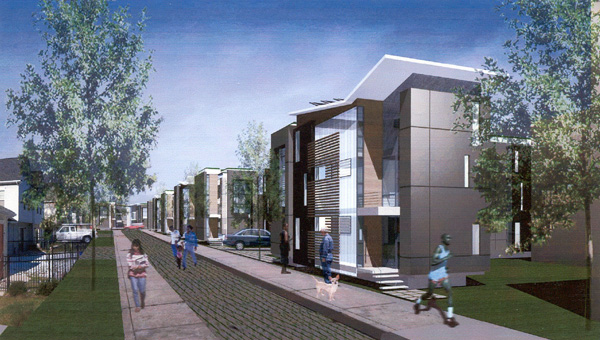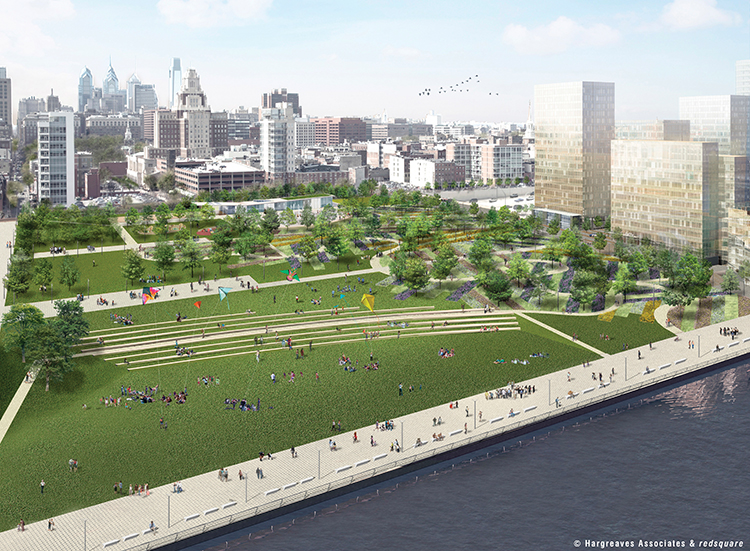 story by samantha wittchenThe 1800 Block of Sheridan Street in North Philadelphia defies the expectations of what affordable housing looks like. The homes aren’t suburban style, semi-detached houses, or the 1950s high-rises they replaced. Instead, you’ll find a block of sleekly designed, eco-friendly homes.
story by samantha wittchenThe 1800 Block of Sheridan Street in North Philadelphia defies the expectations of what affordable housing looks like. The homes aren’t suburban style, semi-detached houses, or the 1950s high-rises they replaced. Instead, you’ll find a block of sleekly designed, eco-friendly homes.
Designed by Interface Studio Architects (ISA), the 13 homes on Sheridan Street were built for the Asociación Puertorriqueños en Marcha (APM) in response to the Community Design Collaborative’s 2005 Affordable Infill Housing Design Challenge. Infill Philadelphia is a design initiative by the Collaborative to revitalize neighborhoods by re-envisioning vacant buildings and spaces.
APM, which is well-known for developing extensive affordable housing in the blocks just east of Temple University, found through focus groups that APM’s community wanted green housing options, according to Rose Gray, APM’s Vice President of Community and Economic Development. The Sheridan homes, slated for LEED Gold certification, have solar hot water, pervious pavement that allows rainwater to seep through, and green roofs, among other sustainable features. However, it’s the design that truly makes these homes unique.
 “The defining characteristic of the project was its ridiculous dimensional constraint,” says Brian Phillips, ISA Principal and Collaborative board member. The block is 450 feet long and 39 feet deep—extremely long and skinny—which made it tricky to design houses that would conform to the Pennsylvania Housing Finance Agency’s (PHFA) 1,300 square-feet, three bedroom, 1.5 bathroom standard requirements. So ISA decided to re-conceive the process of developing affordable housing.
“The defining characteristic of the project was its ridiculous dimensional constraint,” says Brian Phillips, ISA Principal and Collaborative board member. The block is 450 feet long and 39 feet deep—extremely long and skinny—which made it tricky to design houses that would conform to the Pennsylvania Housing Finance Agency’s (PHFA) 1,300 square-feet, three bedroom, 1.5 bathroom standard requirements. So ISA decided to re-conceive the process of developing affordable housing.
Instead of starting with preconceived notions about how the houses should look, or accepting the idea that, because the budget was limited, the houses would inevitably be low-quality, ISA first looked at the performance requirements of the houses. Then, they designed them to meet those requirements within the budget. The result is six L-shaped couplets of homes (there is one unit that is not a twin) that all feel like they open to the street, even though some don’t. It’s very different from the “filing cabinet” layout of homes so prevalent in Philadelphia, Phillips says.
In fact, it works so well that it attracted the attention of Postgreen’s Chad Ludeman, who approached Phillips after a presentation on the project. A series of coffee shop meetings between Phillips and Ludeman led to the 100K House project, Postgreen’s flagship affordable, market-priced, LEED-certified homes. Since then, ISA has designed all of Postgreen’s projects.
Phillips says that there’s a strong synergy between the 100K House and the Sheridan Street Homes. While one’s been featured in the upscale architecture magazine Dwell, the other has appeared in the Pennsylvania Housing Finance Agency newsletter. They’re so similar in aesthetic and design strategy that they’re beginning to bridge the gap between affordable and market-rate housing, making green available to everyone.




There are a number of motives to building green, including environmental, economic, and social benefits. However, modern sustainability initiatives call for an integrated and synergistic design to both new construction and in the retrofitting of an existing structure.
There are a number of motives to building green, including environmental, economic, and social benefits. However, modern sustainability initiatives call for an integrated and synergistic design to both new construction and in the retrofitting of an existing structure.
Whoa, these are houses homeowners would love to own! These houses boast of quality through green roofs, the use of alternative energy and sustainable architecture. This is a breath of fresh air in Philadelphia where property maintenance has become a second thought.
[Mary Martin]
Whoa, these are houses homeowners would love to own! These houses boast of quality through green roofs, the use of alternative energy and sustainable architecture. This is a breath of fresh air in Philadelphia where property maintenance has become a second thought.
[Mary Martin]